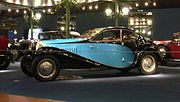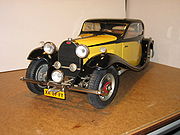
Bugatti Type 46
Encyclopedia

Type 46
The Type 46 used a 5.4 L (5359 cc/327 in³) straight-8Straight-8
The straight-eight engine or inline-eight engine is an eight-cylinder internal combustion engine with all eight cylinders mounted in a straight line along the crankcase...
engine with 3 valves per cylinder
Multi-valve
In automotive engineering a multi-valve or multivalve engine is one where each cylinder has more than two valves. A multi-valve engine has better breathing and can operate at higher revolutions per minute than a two-valve engine, delivering more power.- Multi-valve rationale :A multi-valve design...
driven by a single overhead camshaft. Power was reported at 140 hp (104 kW). The engine was undersquare like most Bugatti designs with an 81 mm bore and 130 mm stroke.
The Type 46 was a large car, weighing 2500 lb (1134 kg) and riding on a 138 in (3505 mm) wheelbase. 400 examples were produced from the end of 1929 through 1936. The three speed gearbox was in unit with the live rear axle, resulting in high unsprung weight, and a relatively harsh ride. Despite this, the model was a favourite of Le Patron, and it remained in production longer than might have been expected
Type 46S
A supercharged version, the Type 46S, was introduced in 1930. With just 160 hp (119 kW), from its Rootes-type blower, it was not a great success. 18 supercharged cars were made in all.Type 50
The Type 50 was a sporting coupeCoupé
A coupé or coupe is a closed car body style , the precise definition of which varies from manufacturer to manufacturer, and over time...
version of the Type 46. It rode on a shorter wheelbase, 122 in (3099 mm), and used a smaller 5.0 L (4972 cc/303 in³) version of the engine. This engine had squarer dimensions, however, at 86 by 107 mm, and twin camshafts actuated two valves per cylinder. Power output was impressive at 225 hp (167 kW). Many cars had landaulet
Landaulet
A landaulet or landaulette is a car body style, "an enclosed sedan or coupé with a folding top at the extreme rear quarter, over the rear seat."...
roofs and Bugatti
Bugatti
Automobiles E. Bugatti was a French car manufacturer founded in 1909 in Molsheim, Alsace, as a manufacturer of high-performance automobiles by Italian-born Ettore Bugatti....
-style two-tone paint.
Type 50T

Type 50B
A racing version, the Type 50B, was also produced. It shared the 5.0 L 2-valve engine but was blown to produce 470 hp (350 kW). It was used from 1937 through 1939. A pair of these engines were installed in the Bugatti P100 airplane, with specially cast magnesiumMagnesium
Magnesium is a chemical element with the symbol Mg, atomic number 12, and common oxidation number +2. It is an alkaline earth metal and the eighth most abundant element in the Earth's crust and ninth in the known universe as a whole...
crankcases.

